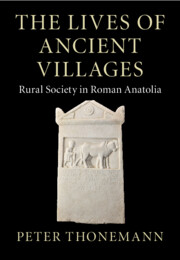Book contents
- The Lives of Ancient Villages
- Greek Culture in the Roman World
- The Lives of Ancient Villages
- Copyright page
- Contents
- Figures
- Tables
- Preface
- Abbreviations
- Maps
- 1 Hieradoumia
- 2 Commemorative Cultures
- 3 Demography
- 4 Kinship Terminology
- 5 Household Forms
- 6 The Circulation of Children
- 7 Beyond the Family
- 8 Rural Sanctuaries
- 9 Village Society
- 10 City, Village, Kin-Group
- References
- Index
2 - Commemorative Cultures
Published online by Cambridge University Press: 28 October 2022
- The Lives of Ancient Villages
- Greek Culture in the Roman World
- The Lives of Ancient Villages
- Copyright page
- Contents
- Figures
- Tables
- Preface
- Abbreviations
- Maps
- 1 Hieradoumia
- 2 Commemorative Cultures
- 3 Demography
- 4 Kinship Terminology
- 5 Household Forms
- 6 The Circulation of Children
- 7 Beyond the Family
- 8 Rural Sanctuaries
- 9 Village Society
- 10 City, Village, Kin-Group
- References
- Index
Summary
This chapter introduces the two inscribed monument types which were characteristic of Roman Hieradoumia: the familial epitaph and the propitiation-stēlē. Both categories of monument tend to be dated by year, month, and day, which allows us to map the development of the epigraphic habit in the region with unusual precision. Hieradoumian tombstones generally take the form of pedimental marble stēlai, often bearing a depiction of a wreath, either incised or in relief. The associated funerary inscriptions have a highly stereotyped structure, in which the deceased is ‘honoured’ by a smaller or larger group of family members, whose relation to the deceased is very precisely defined. These funerary monuments have several formal similarities to the propitiation-stēlai erected in many Hieradoumian rural sanctuaries, which narrate individual transgressions, divine punishments, and acts of propitiation. Taken together, these two categories of ‘commemorative’ monument provide a vivid picture of the moral universe of rural Hieradoumia in the first three centuries AD.
- Type
- Chapter
- Information
- The Lives of Ancient VillagesRural Society in Roman Anatolia, pp. 25 - 71Publisher: Cambridge University PressPrint publication year: 2022

